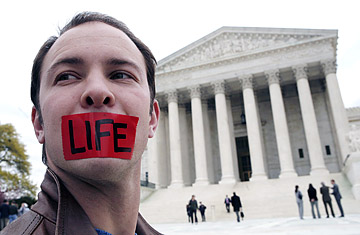
Pro-life supporter Josh Alcorn demonstrates in front of the Supreme Court after the Court upheld the first nationwide ban on a specific abortion procedure, in Washington, April 18, 2007.
Make no mistake, abortion opponents won big in this case, Gonzales v. Carhart. It's the first time that the court has blessed a federal ban on an abortion method, and a serious blow to the longstanding rule that abortion restrictions must permit the procedure when necessary to preserve a woman's health. The slim majority here — five conservative justices led by Anthony Kennedy — skirted that rule by saying medical experts can't agree whether a woman would ever need this method to stay healthy (the law does contain an exception if the woman's life is at stake). So, they argued, the absence of a health exception doesn't make the law unconstitutional on its face — a substantial nick in the armor that has protected the right to abortion since 1973.
The court also turned back arguments that the law was too vague and an "undue burden" on the constitutional right. The law's challengers said its imprecision would stop not only "intact D&E" — the controversial process of removing the fetus whole (hence the phrase partial birth) — but also standard D&E, which involves removing the fetus in pieces. Together, the procedures account for most second-trimester abortions. But Kennedy, writing for the court majority of himself, Clarence Thomas, Antonin Scalia, John Roberts and Samuel Alito, said the statute was plenty precise, especially since a doctor couldn't violate it without "intending" to perform an intact D&E. And since there are lots of other abortion methods, Kennedy explained, banning this one wouldn't be much of a burden on a woman's rights.
So what could the pro-choice crowd possibly find pleasing here? Well, for what it's worth, Justice Ruth Bader Ginsburg wrote a very compelling dissent, joined by three of her liberal colleagues, Stephen Breyer, John Paul Stevens and David Souter. It's as fiery as anything turned out by conservative rabble-rouser Antonin Scalia, probably the court's best writer. She dismisses the majority's logic as "bewildering," the product of old men out of touch: "This way of thinking reflects ancient notions about women's place in the family and under the Constitution — ideas that have long since been discredited."
But the best news for abortion-rights supporters may be what didn't happen in this case. We've all been waiting to see where the court's two Bush appointees — Chief Justice John Roberts and Justice Samuel Alito — stand on Roe v. Wade, and when given the chance to repudiate it in this case, both justices declined. That opportunity came in the form of a separate opinion that Justice Clarence Thomas wrote and Scalia joined but both Roberts and Alito did not endorse — a concurrence that not only supports the majority, but goes so far as to say there shouldn't even be a constitutional right to abortion.
Of more practical help to pro-choice advocates may be the majority opinion's suggestion that there's another way to challenge the ban: in a case where a specific woman would probably get sick if she didn't undergo an intact D&E. In this so-called "as applied" challenge, the court could see when the procedure was necessary to protect a woman's health and rule the law unconstitutional in those situations. (As the dissent points out, there may be logistical problems with how this would work in practice). It wouldn't be a total victory for abortion rights, but it would be better than nothing.
A second way to attack the law happens to emerge from Thomas' concurring opinion, which also mentions the issue of "whether the Act constitutes a permissible exercise of Congress' power under the Commerce Clause." In other words, even as he supports the intact D& E law, Thomas wonders whether Congress actually can pass such a national ban on an abortion procedure, or whether that's a power reserved exclusively to the states. The issue wasn't raised in this case, but the implication is that the court might strike down the intact law as beyond Congress' power to regulate interstate commerce.
Both alternatives have drawbacks. In suggesting the "as applied" challenge, the court was also saying it might no longer accept the more general method of challenging abortion restrictions based on the argument that they are unconstitutional on their face. And while a commerce clause argument might cut down the intact D&E law, it might also spell the end to federal laws like the one barring picketing of abortion clinics.
